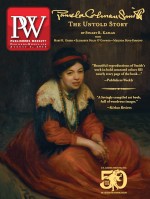Set in 1872, Abdul-Jabbar’s second novel coauthored with Anna Waterhouse, Mycroft and Sherlock (Titan, Oct.), finds the brothers investigating a series of bizarre murders in London.
The most challenging aspect to writing my Mycroft Holmes novels is that nothing about Mycroft and Sherlock’s world can be taken for granted or assumed. For example, a person living in Newport, Maine, can have a pretty good idea what life is like in Newport Beach, Calif.—in spite of the fact that the places are separated by more than 3,000 miles; that temperatures in one can vary by 60 degrees; or that the other has barely seen snow. In our present day, there is still a sense of commonality, of living the same life. But that sense of commonality goes out the window when you write about the past.
In our case, my coauthor and I are telling stories that take place in Victorian England. Our principal protagonist, Mycroft Holmes, lives in St. John’s Wood, London. When he walks out his door, we have to construct his world nearly from scratch. What does he see? What might he hear? What odors would assail his senses? What’s the protocol for something as simple as greeting a neighbor?
To make it more complex, the two novels have prominently featured Mycroft’s brother, a then-18-year-old Sherlock Holmes. And the original author of these brilliant characters, Arthur Conan Doyle, is not particularly helpful, for his stories take place 20 or 30 years after ours, when the brothers are middle-aged men.
But as fascinating as the many differences are the similarities, especially when they form the root of contemporary problems. For instance, in Mycroft and Sherlock, Victorian England was undergoing an opioid crisis. Opium and morphine were everywhere, as were addicts. And Britain was not only loath to curb consumption: drug use was actively encouraged. Drugs were perfectly legal, and there was very big money to be made. When you research it, it’s easy to see that the scourge of our own addiction in this country has roots dating back several centuries. In the third book, which we’re writing now, we touch on a terrible monetary crisis that engulfed Europe and the U.S., and which mimics both the Great Depression and the more recent economic collapse of 2008. One of the culprits, then as now? Easy loans, badly structured.
So, while the manners and mores have to be investigated with a fine-tooth comb (which was the practice of using a comb with close-set teeth to comb out lice in the late 1800s), human frailty, greed, and gullibility are all strangely consistent. That was something Conan Doyle knew when he first came up with his brilliant characters, and that’s the lesson we recall again and again as we write today.



 Volume 265
Issue 32
08/06/2018
Volume 265
Issue 32
08/06/2018





